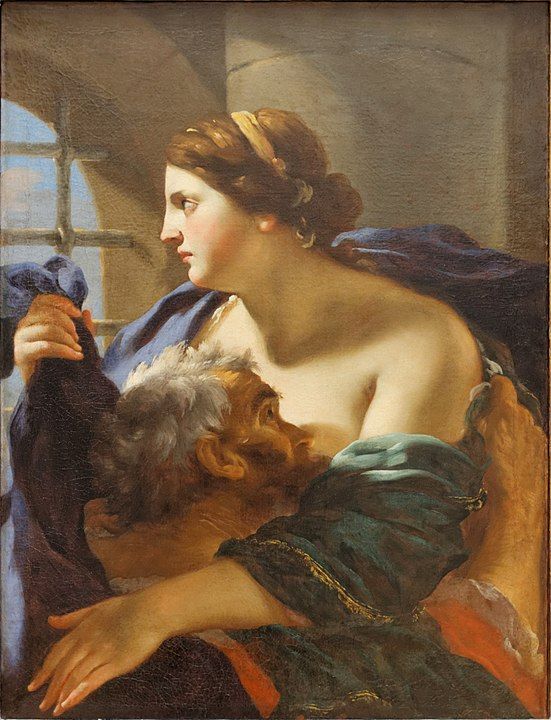Roman Charity (1623) depicts a young woman breast feeding an older man. The painting has a deep, dark background with very few brown highlights. There are two primary figures. A young woman kneels on the left side of the painting. She has a headwrap, skirt, and cloth covering some of the upper half of her body. This woman’s shoulders and breasts are exposed, she is using her right hand to lift her left breast to feed the subject in front of her. The man taking up the right side of the painting faces the woman with his hands shackled behind his back. He has no clothes on, but his lower half is draped in a vibrant, red cloth. Although the woman is kneeling, she is still at a higher position than the man, and her head is angled toward him. While the man’s head is angled slightly upward, he is directly facing her breast, not her face. A very faint, voyeuristic figure exists behind the woman’s left hand and head, behind her left shoulder. This figure, difficult to see, adds depth to the story in the painting. Initial reactions to Hendrick ter Brugghen’s Roman Charity (1623) may be those of disgust or confusion. The painting invokes strong responses from viewers, and whether one might care to examine it for what is really at stake will determine their response. It could be viewed as taboo and in the modern world, often people make up their minds about something very quickly and are very polarized by it. Therefore, viewers should be urged to take a longer look and delve deeper into the backstory of the primary subjects in Ter Brugghen’s painting. It tells a true story, that is much more than what meets the eye. The story this painting tells is one that was greatly revered in the seventeenth century, it was not frowned upon or seen as offensive by many. The Metropolitan Museum of Art, where the painting is displayed, relays the information that the historical event Roman historian Valerius Maximus recorded was “... celebrated in seventeenth-century Europe as an exemplar of filial piety.” (www.metmuseum.org.) Roman Charity (1623) must be examined for deeper meaning, there is much more depth of story than what originally meets the eye. The subjects of the painting are in a dark place, literally and metaphorically. The background of the painting has very few details. The woman is Pero and the man is her father, Cimon, who was “sentenced to death by starvation” (www.metmuseum.org). Cimon is imprisoned and left alone for dead. Pero would visit her father to feed him at night, when she would be least likely to be caught. The background is very dark, which makes it difficult to discern any of the shapes. However, there are some shapes that are highlighted in the background. There is a dark circle behind Cimon’s right elbow, and the right side of the painting contains a dark rectangle that could be an entranceway to the prison. The dark, obscure background is not without intention. It is vague to make the voyeuristic figure blend in and allow for the knowledge that it is nighttime. No sexualization is present in Ter Brugghen’s painting, just as no sexual nature exists in this story. This is clear because her positioning is very closed off to anyone except the man she is feeding. The rest of her body is covered. She has a dark orange headwrap and a long blue and dark orange striped skirt covering her body. Draped around her shoulders, is a green patterned fabric that covers her midriff. This green fabric and the cloth seen faintly in her left hand presumably covered her breasts and shoulders before and after this scene. This inclusion of cloth and Ter Brugghen’s using it to maintain as much modesty as possible show the severity of the situation. Pero is not exposing her breasts as to arouse anyone. Flirtation is totally absent from this story and, therefore, his painting. Pero is not only depicted as covering herself up, but her body positioning tells a story of her feeling indignity, despite her actions being selfless. Her shoulders are angled toward her father. She is attempting to hide herself from the outside world as much as possible. Her right hand is used to angle her breast into her father's mouth, for the sole purpose of feeding him. Ter Brugghen chose not to paint her nipples as a prominent feature in this painting as another way to maintain her honor. His choice to position her hand in such a way that is purely logical epitomizes the lack of sensuality present. Her left arm is bent at the elbow and her left hand is holding some sort of cloth, likely used in the covering or wrapping of herself. Again, telling the practicality of it all, nothing is glamorized. Cimon’s body positioning emphasizes the urgency of the situation. He is almost completely squared off to her, but his shackles keep him from facing her straightforward. This position allows for the viewing of most of his body. His right knee is covered in a red cloth, as is his left hip, lower back, and presumably his groin area. The audience of the painting cannot see his genitalia; he maintains some of his dignity in this way. He is not fully exposed to his daughter, which is important because although he does not have any pride left and needs her help at this moment. He can maintain this little privacy. His legs are bent at the knee as if he scooted himself closer to Pero, trying to reach her. His legs are thin and spread enough so that he can come to her breast to be fed. His face and neck are much redder than his head and back, this detail gives insight into his past. He was likely a man who worked in the sun and was aged by it. Cimon is starving and needs to be fed; that is the only motivation he has. There is no subtext; he is trying to attain nutrients and that is why he is positioned this way. The voyeuristic character in the background of this painting exemplifies society’s reaction to the subjects. The eyes and nose are the most prominent, if not only visible features. The figure looks surprised and concerned, not angry or eager to exclaim what he is seeing. However, it makes this less of a private moment; there is the fear of being seen and reported. This moment out of context, in the way voyeuristic figure sees it, is extremely taboo. Despite their attempts to be hidden and secretive, the figure is leering in the background anyway. It is an intense moment that could end in violence and the voyeur is included to emphasize the threat of being caught in the act. The title of this painting Roman Charity uses ‘Charity’ as a personification. It makes the painting universal. The voyeuristic figure is not completely visible and perceivable. He is not fully identifiable so that the painting remains universal. The message is timeless and understood by many cultures and different people, because in a way the viewer themselves, a voyeur. Pero’s and Cimon’s eyes exemplify the message of the painting. Her eyes are fully closed and his just slightly opened. So much weight lies in the choices to present them this way. Neither subject can look the situation in the eye. She is clearly willing to do whatever it takes to help her father survive, but she knows that it is at a great cost to her body and her reputation. His eyes are barely open, exemplifying his shame. Any father would feel so wrong about having to do something like this. Even though the painting depicts it as a selfless act, the very mechanics of being breastfed has some sexuality to it. It is undeniable. No father should see his adult daughter's breasts, but the severity of this situation makes it a necessity. His eyes are just open enough to see where to put his head. These two cannot look at each other. They cannot face the reality of what they are experiencing. Roman Charity relays only one of the many stories of sacrifice and struggle during this time period. The Baroque period lasted from around 1600 to about 1750. This period of art is heavily influenced by what is occurring in the world that the artists are living in, and Ter Brugghen was born in 1588, just twelve years after The Spoyle of Antwerpe was written. At that time, religious persecution was running rampant throughout Europe. George Gascoigne’s pamphlet, The Spoyle of Antwerpe (1576), details some of the effects of one of the many conflicts between Protestants and Catholics. This was a period of horrid, mass killing by the Spaniards based in religious persecution. However, said persecution went beyond religion, age, or class in this case. Gascoigne notes, in the beginning of his writing, “They neither spared age, nor sex: time nor place: person nor country: professions nor religion: young nor old...” (Wren). Gascoigne tells not only of the murders, but also the rape and pillaging that took place. No lives were spared, and the city was destroyed. Roman Charity (1623) is not based on the Antwerp attack by any means, but they do have some shared themes. Cimon is comparable to the people of Antwerp who were met with absolute brutality as it is described in Gascoigne’s pamphlet. Cimon’s suffering is not unlike the suffering of the people of Antwerp. The people of Antwerp did not commit a crime like Cimon, but despite that, are faced with harsh death. Both victims of suffering are cruelly punished and left for dead. However, the people of Antwerp did not have a Pero. She is the only chance Cimon has at survival. There was no one coming to Antwerp to rescue or sacrifice to help them survive. They had no symbol for hope. In the same vein, Gascoigne could be compared to the voyeur. Gascoigne was an English diplomat who was in Antwerp when the Spanish attacked. He, like the voyeur, is an outside presence viewing the event. Neither of these two figures are creating the conflict themselves. They were not one of the people suffering, nor were they there to save them. Gascoigne has strong opinions on what is happening, so the audience reading the pamphlet is shown only one perspective. On the other hand, the voyeuristic character in Roman Charity invites the audience into the painting and makes said audience consider their opinion on the scene at hand. Despite Gascoigne’s clearer standing on what he is seeing, he is still an outside perspective. These two artifacts of history, perhaps abstractly, are certainly intertwined. Ter Brugghen’s heart wrenching Roman Charity (1623) embodies what it is to love someone unconditionally. It expresses what it looks like to risk your dignity to survive, or to help those you love most to survive. The positioning of the bodies, the dark brooding background, and the overall lack of flashy, cheap attention-grabbing methods convey that message. It is not a painting made to offend or shock, although these are valid initial reactions. Nothing is glamorous about sacrificing societal decency, and yet the details of this painting are quite elegant. There are so many contrasting elements in this painting, making it just as complex as the story it is telling. The painting’s significance lies in its ability to transcend cultures and appeal to people universally. It celebrates the courage and selflessness it would take to save a loved one in this way, which is impactful to people regardless of where or what they come from.
Works Cited “Roman Charity.” Metmuseum.org, https://www.metmuseum.org/art/collection/search/834308.
Wren, Linnea H. Perspectives on Western Art: Source Documents and Readings from the Renaissance to the 1970s. ROUTLEDGE, 1994

Haley Jane Massey is currently a junior at Marymount Manhattan College pursuing her BFA in Musical Theatre. Her academic passions expand beyond acting, singing, and dancing. She is from Nashville, Tennessee and is very grateful to be living in NYC exploring all of the opportunities it has to offer.

